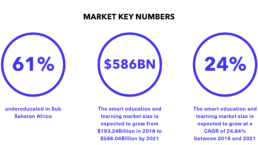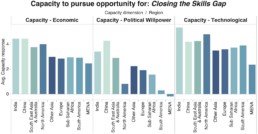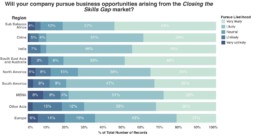The mismatch of the supply and demand of skills is like a puzzle that won’t fit. Repairing this puzzle is an opportunity to tap into a resource for the future: youth.
The mismatch between supply and demand of skills will increase according to projections. At a global level, projections show that by 2020 the global economy will run short of 40 million workers with a tertiary education and 45 million workers with a secondary education in developing economies, while there will be 95 million more low-skilled workers than needed. If just a fraction of the demand could be met by updating the skills of a fraction of the low skilled workers, it would have a tremendous effect on the economy and on the lives of the people concerned for the rest of their lives.

A Flexible Mindset
Globally we are locked into a mindset of perceiving tertiary education as better than hands-on professions. However, taking a more flexible attitude towards education can help bridge the skills gap. Education for a changing labor market needs to be flexible, giving youth the ability to learn skills in general or learn how to learn more when needed. Practical tools and challenges can update skills with great benefits for business, society, and youth. To create a more adjustable education system, we need to foster closer relations between employers, education providers, and youth to close the skills gap. This will both help youths to make educational choices informed by labor market demands and support efforts to upskill and adjust competencies to meet the ever-changing demands of the labor market.
Business – A Key Player
Businesses are uniquely positioned to provide youth with the employable skills needed to enter the labor market. Governments can incentivize business to offer apprenticeships and on-the-job training by re-thinking unemployment benefits, so businesses are compensated when they offer ‘job training’ to unemployed youth. It is a way for business to test potential future employees and develop a skills pipeline. Vocational training options in the informal sector are, in some parts of the world, an avenue to learn practical skills, which in turn will increase employability.
The development of e-learning programs by business is also a true game changer. The right content using easily accessible e-learning technology can be a driver to upskill and reskill youth worldwide. Business can tap into an e-learning market growing rapidly within an increasingly connected world. It requires a collaborative approach to education, vocational training, on the job competence building, and skills development in formal institutions (universities and schools) and jobs.
Matching Skills Demand and Supply
Enhancing the links between business and formal education can enrich the business ecosystem and help more ideas blossom, launch more job-creating start-ups, and help more companies find skilled labor and innovations. Businesses are redesigning work at such high speed that educational institutions are finding it difficult to adapt accordingly. This opens an opportunity for those who can facilitate closer collaboration between business and educational institutions on how to manage on-going adaptation of curricula in response to the shifting competences demanded by businesses. Developing five-year skills forecasts at the level of businesses will help guide both educational institutions and youth in the shifting skills demands on the labor market.
The development of e-learning programs by business is also a true game changer. The right content using easily accessible e-learning technology can be a driver to upskill and reskill youth worldwide. Business can tap into an e-learning market growing rapidly within an increasingly connected world. It requires a collaborative approach to education, vocational training, on the job competence building, and skills development in formal institutions (universities and schools) and jobs.
Survey Findings
Closing the Skills Gap was a very positively rated market opportunity when surveyed in 2015. It sends a strong signal that opportunities to address the risk of a wasted generation to unemployment are seen to hold great benefits for society.

In Europe and North America, survey respondents have taken a shine to “Closing the Skills Gap” rating it very positively. The regions of South America and MENA have the lowest levels of belief in this market opportunity. For the MENA region capacity to pursue this opportunity is rated strikingly low, even though, respondents in the region see societal benefits stemming from the opportunity. There is agreement across all regions that we do have the technology at hand to make this opportunity real – except for the MENA region.
For very high HDI countries as well as respondents aged above thirty years, this market opportunity is rated very positively.

Both manufacturing, service and the other business sectors have assessed this opportunity to be one that will have a lot of effect on their business. “Closing the Skills Gap” is also ranked very positively by the financial and governmental sector. The financial sector and other business sector have perceived this opportunity to be the one they will most likely pursue new business opportunities within, and the other business sectors also echo this opinion. It is the opportunity which is perceived by business to hold the greatest new market potentials of the fifteen market opportunities surveyed in 2015.
This market was surveyed globally in 2015 by more than 5500 leaders from both the public and private sectors. The survey was conducted in collaboration with the research company YouGov. The survey results were originally published in the Global Opportunity Report 2016.

